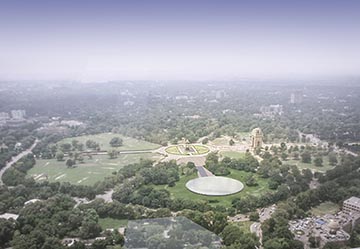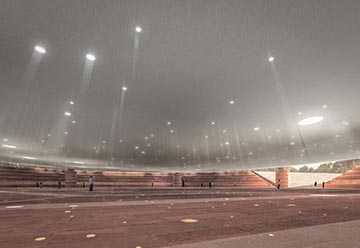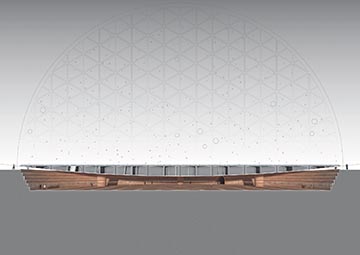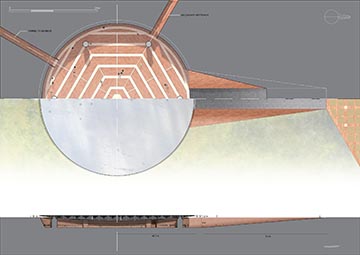
Indian National War Memorial
インド国立戦没者メモリアル
The National War Memorial at the ‘C’ hexagon in New Delhi seeks to commemorate the lives of the radiant individuals who sacrificed themselves for their country. The memorial is a representation of the diverse cultural traditions that they represented as proud Indians. It is a space of reckoning and quiet contemplation where the present generation can gather and appreciate the value of freedom their ancestors fought so hard to protect.
Evoking the spirit of the Indian national flower, the Lotus, the design seeks to imbibe the spirit of purity, sanctity, humility and the formative characteristics of the pure and round profile and the gentle curve of the flower. As an unassuming yet dignified symbol of remembrance, the form is identified by a perfectly circular basin of water communicating the concept of reverse abstraction with the site being the water and the structure being the lotus blossoming peacefully in its surroundings.
Rising gently out of the grounds of Lawn 1 at the ‘C’ hexagon complex, the memorial presents itself as a calm mirror of the context floating just above the turf. Referencing the ceremonial axis of Rajpath right from the Rashtrapati Bhavan to the India Gate Chattri, the memorial is located at the axial intersection of India Gate and the Chattri. One approaches the memorial from a 12m wide ceremonial ramp perpendicular to Rajpath that inclines to a depth of 6m below ground level. The memorial space contains a vast hall of contemplation bordered by a staggered wall with plaques commemorating the brave. It offers a peaceful sanctuary for quiet tributes. The basin of water is elevated just enough to sufficiently allow daylight to enter the memorial sanctum. Apart from the ceremonial access, the memorial can also be accessed by two secondary entry points on either side of Lawn 1 that further connect Lawns 2 and 3. A tunnel access has also been provided to access the future National War Museum located at Princess Park. Princess Park.
Reflecting back to the ancient Indian traditions of Vāstu Shastra, the Vedic space dimensioning system has been adopted as a standard module for the resolution of the form. The diameter of the water basin is 91.44 meter of 200 Hastas, 1 Hasta being the length of a forearm (45.72 cm); a standard Vāstu module. The columns, each having a diameter of 7 Hastas are circumscribed on a circle 160 Hastas in diameter. The structural grid supporting the basin is a honeycomb with each hexagon spaced 20 Hastas apart. The supporting ribs radially connect the center of the basin and the end points of the grid.
For many, the noblest way to pass from mortal existence is to do so while serving your nation. To celebrate the glory of every fallen soldier, the ceiling of the memorial is interspersed with a celestial pattern mimicking the starlit sky. The pattern is created by juxtaposing the sky chart at the end of every major war since independence corresponding to the exact site location. The idea is that when one looks up at the ceiling, the refracted beams of sunlight remind one of how India as a nation and thousands of Indian soldiers have protected the very ideals of liberty and peace and continue to do so on a daily basis.




